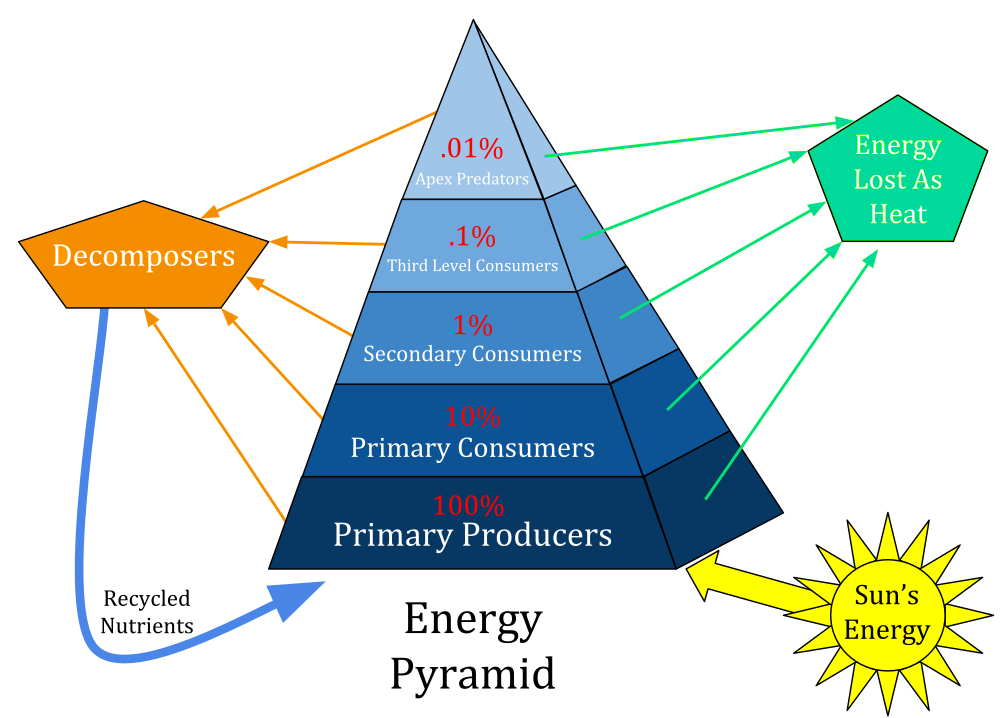1.1 Introduction to Energy and Matter
Christelle Sabatier
Learning Objectives
- Compare and contrast between energy and matter.
We live on a planet bathed in sunlight, our primary source of energy. From this source, all of life has arisen. The cells that make up all organisms from single-celled bacteria to meters-tall trees and blue whales require two fundamental things in order to make up the diversity of life all around us: energy and matter.

Organisms need to acquire new matter if they are to grow and reproduce. Matter is any substance that has mass and volume. In biological systems, matter comes in the form of nutrients that make up all of the molecules that are required for life. These nutrients can be found in the atmosphere, in the soil, and in other organisms. They in turn are made up of the fundamental elements of life, which are transformed from one form to another through chemical reactions. In the following chapters, you will learn about these fundamental elements, how they are taken up by cells and organisms, and where we can find them in the molecules of life. You will also explore how the availability of these elements and their ability to move from one organism to another can shape the populations of animals, plants, fungi, and bacteria that make up life on this planet. Importantly, matter is recycled from inorganic forms to organic forms and back again.
Organisms also need energy for maintenance, growth, and reproduction. Energy is critical to the work and change that takes place in biological systems. Energy too undergoes many transformations. These transformations require a coordinated dance between matter and energy. The energy in sunlight can be captured into the chemical bonds of a sugar molecule. The energy held in a sugar molecule can be extracted to power much of the work of cells and organisms. Unlike matter, however, energy is not completely recycled. Much is lost as heat to the universe.
Underneath this process that dictates the composition of organisms in vastly different ecosystems across the planet, there are fundamental chemical, cellular, and organismal processes that guide and control these transformations of energy and matter. We will explore these throughout BIOL 1A and in the first 12 chapters of this book, ever mindful that what happens at a small scale has impacts on the larger scales.
Practice Question
Glossary
- primary producer
- organisms that make their own food through photosynthesis or chemosynthesis, forming the base of the food chain
-
- consumer
- herbivorous organisms that eat other organisms to obtain energy
-
-
-
-
- decomposers
- organisms that break down dead organisms and recycle nutrients back into the ecosystem
-
-
-
Figure Descriptions
Figure 1.1.1. The image depicts an energy pyramid illustrating the flow of energy in an ecosystem. The pyramid has multiple levels, each representing a different trophic level. At the base is the “Primary Producers” level labeled 100%, shown in light blue; these organisms capture the Sun’s energy. Above them are the “Primary Consumers” labeled 10% in a darker blue, followed by “Secondary Consumers” at 1% and “Third Level Consumers” at 0.1%, each in progressively darker shades of blue. At the top of the pyramid are “Apex Predators” at 0.01%, in the darkest blue. To the right of the pyramid, green arrows labeled “Energy Lost As Heat” indicate energy loss at each level. To the left, an orange arrow leads to a hexagon labeled “Decomposers,” which arrows connect to each pyramid level, illustrating their role in breaking down materials. At the bottom right is a yellow circle symbolizing the “Sun’s Energy” with an arrow pointing to the base of the pyramid. [Return to Figure 1.1.1]
Media Attributions
- Ecological_Pyramid © Swiggity.Swag.YOLO.Bro is licensed under a CC BY-SA (Attribution ShareAlike) license
physical substance that which occupies space and possesses mass.
a group of atoms bonded together, representing the smallest fundamental unit of a chemical compound that can take part in a chemical reaction.
